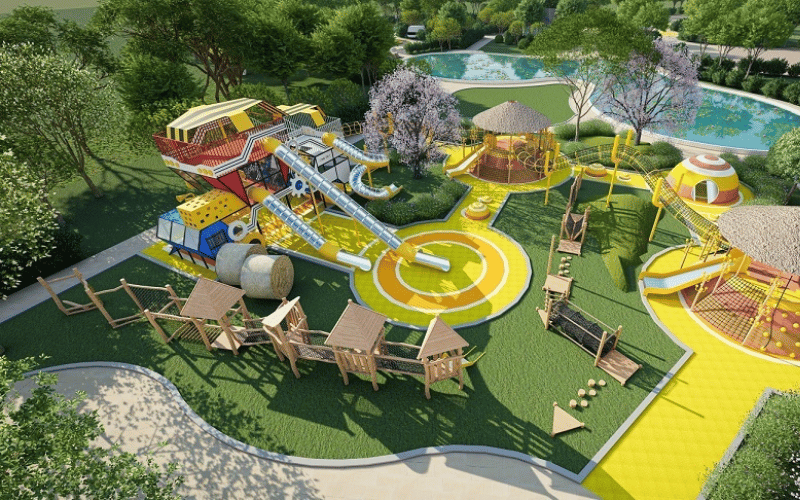Playgrounds are essential spaces for children’s physical, social, and cognitive development. However, poor design choices can turn these areas into hazardous or unengaging environments. While parents and caregivers may not always notice the flaws in playground layouts, designers and city planners must prioritize safety, accessibility, and creativity to ensure these spaces serve their purpose effectively.
Let’s examine some of the most common mistakes in children’s playground design, how they impact usability, and what can be done to create better play environments.
Table of Contents
ToggleOveremphasizing Visual Appeal Over Practicality
- Mistake: Many playground designs focus heavily on elaborate decorations or intricate color schemes, prioritizing aesthetics while neglecting practicality and functionality. This often results in a playground that looks attractive but is inconvenient and less user-friendly.
- Solution: Balance visual appeal with functionality. Ensure the layout accommodates practical needs, such as well-placed play equipment, convenient rest areas, and spaces that allow parents to supervise easily. Use vibrant yet simple colors and designs to create an engaging environment that doesn’t overwhelm the space.
By focusing on both aesthetics and functionality, your playground can be a visually pleasing yet practical space for children and their caregivers.
Mismatch Between Playground Style and Surroundings
- Mistake: Some playgrounds fail to align their design with the architectural style and surrounding environment, creating a disharmonious and out-of-place appearance.
- Solution: Conduct a thorough analysis of the surrounding environment before starting renovations. Ensure the playground design complements the nearby buildings and landscapes. Draw inspiration from the area’s aesthetic features to make the playground a seamless and appealing part of its environment.
By integrating the playground’s style with its surroundings, you can create a cohesive and welcoming space that enhances the overall environment.
Neglecting Children’s Psychological Needs and Interests
- Mistake: Some playgrounds adopt decor styles and elements that are too adult-focused or misaligned with children’s preferences, ignoring their psychological needs and creative interests.
- Solution: Incorporate design elements that resonate with children’s aesthetics and spark their imagination. Themes like cartoon characters, animals, or vibrant patterns can capture their interest. Use playful colors, shapes, and materials to stimulate creativity and make the space truly child-friendly.
By focusing on children’s perspectives, you can create a playground that captivates their imagination and fosters joyful exploration.
Lack of Innovation and Uniqueness
- Mistake: Many playgrounds follow conventional design styles, resulting in a lack of distinctive features and failing to captivate visitors.
- Solution: Prioritize innovation and uniqueness in the design process. Introduce fresh concepts, advanced technologies, or original elements to craft a memorable and appealing playground. Additionally, consider factors such as local culture, market trends, and your target audience’s preferences when developing a personalized and competitive design plan.
By focusing on creativity and tailoring the design to local and market-specific needs, you can create a playground that not only stands out but also keeps visitors coming back.
Neglecting Safety and Environmental Protection
- Mistake: Some playgrounds use materials that are toxic or harmful and fail to implement adequate safety measures, putting children at risk.
- Solution: Prioritize safety and eco-friendliness during the renovation process. Use materials and facilities that meet national safety and environmental standards. Implement comprehensive safety measures, such as installing fences, anti-slip mats, and other protective features, to ensure a secure and child-friendly environment.
Summary
To create a playground that is safe, enjoyable, and visually appealing, avoid these common pitfalls:
- Balance practicality with aesthetics.
- Harmonize the style with the surrounding environment.
- Cater to children’s psychological needs and interests.
- Showcase innovation and originality.
- Ensure safety and environmental protection.
By addressing these elements, you can design a playground that is safe, comfortable, and irresistibly fun for children and their families.






